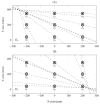High-Accuracy Gaze Estimation for Interpolation-Based Eye-Tracking Methods
- PMID: 34564339
- PMCID: PMC8482219
- DOI: 10.3390/vision5030041
High-Accuracy Gaze Estimation for Interpolation-Based Eye-Tracking Methods
Abstract
This study investigates the influence of the eye-camera location associated with the accuracy and precision of interpolation-based eye-tracking methods. Several factors can negatively influence gaze estimation methods when building a commercial or off-the-shelf eye tracker device, including the eye-camera location in uncalibrated setups. Our experiments show that the eye-camera location combined with the non-coplanarity of the eye plane deforms the eye feature distribution when the eye-camera is far from the eye's optical axis. This paper proposes geometric transformation methods to reshape the eye feature distribution based on the virtual alignment of the eye-camera in the center of the eye's optical axis. The data analysis uses eye-tracking data from a simulated environment and an experiment with 83 volunteer participants (55 males and 28 females). We evaluate the improvements achieved with the proposed methods using Gaussian analysis, which defines a range for high-accuracy gaze estimation between -0.5∘ and 0.5∘. Compared to traditional polynomial-based and homography-based gaze estimation methods, the proposed methods increase the number of gaze estimations in the high-accuracy range.
Keywords: eye tracker; eye-tracking; gaze-mapping calibration; high-accuracy gaze estimation; uncalibrated setup.
Conflict of interest statement
The authors declare no conflict of interest.
Figures














References
-
- Tonsen M., Steil J., Sugano Y., Bulling A. InvisibleEye: Mobile Eye Tracking Using Multiple Low-Resolution Cameras and Learning-Based Gaze Estimation. Proc. ACM Interact. Mob. Wearable Ubiquitous Technol. 2017;1:106:1–106:21. doi: 10.1145/3130971. - DOI
-
- Larumbe A., Cabeza R., Villanueva A. Supervised Descent Method (SDM) Applied to Accurate Pupil Detection in off-the-Shelf Eye Tracking Systems; Proceedings of the 2018 Symposium on Eye Tracking Research & Applications (ETRA ’18); Warsaw, Poland. 14–17 June 2018; New York, NY, USA: ACM; 2018. - DOI
-
- Hansen D.W., Agustin J.S., Villanueva A. Homography normalization for robust gaze estimation in uncalibrated setups; Proceedings of the 2010 Symposium on Eye Tracking Research & Applications (ETRA ’10); Austin, TX, USA. 22–24 March 2010; New York, NY, USA: ACM; 2010. pp. 13–20. - DOI
-
- Hansen D.W., Roholm L., Ferreiros I.G. Robust Glint Detection through Homography Normalization; Proceedings of the 2014 Symposium on Eye Tracking Research & Applications (ETRA ’14); Safety Harbor, FL, USA. 26–28 March 2014; New York, NY, USA: ACM; 2014. pp. 91–94. - DOI
LinkOut - more resources
Full Text Sources
Other Literature Sources

